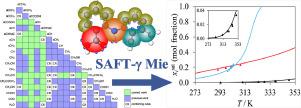Fluid Phase Equilibria ( IF 2.6 ) Pub Date : 2021-03-02 , DOI: 10.1016/j.fluid.2021.113002 Sara A. Febra , Thomas Bernet , Corin Mack , John McGinty , Iyke I. Onyemelukwe , Stephanie J. Urwin , Jan Sefcik , Joop H. ter Horst , Claire S. Adjiman , George Jackson , Amparo Galindo

|
The prediction of the solubility of active pharmaceutical ingredients (APIs) is a significant challenge which is of importance in pharmaceutical applications and solvent selection. Here, we extend the table of group interactions (3 like interactions, 47 unlike interactions) of the SAFT- Mie group-contribution equation of state to model the phase behaviour and solubility of mefenamic acid, a nonsteroidal anti-inflammatory drug, in a range of solvents. In addition to mefenamic acid, we also consider its molecular synthons: benzoic acid and diphenylamine. New experimental solubility data are presented for the three molecules in a range of solvents, and three new SAFT- Mie functional groups are defined (aCCOOH, aCNHaC and CHCO) and characterised, together with their interactions with solvent groups. Literature data for the vapour pressure, single-phase density, saturation density, vapourisation enthalpy, bubble temperature, dew temperature, and bubble pressure are used to characterise the new group interactions. Solubility data are used to characterise the new group-group interactions only if there are no other experimental data available. The transferability and predictive accuracy of the new models are assessed by comparing the theoretical predictions with the experimental solubility data. Our comparison includes alcohols, ketones, and esters as families of solvents and mixed-solvent solubility predictions.
中文翻译:

扩展SAFT- Mie方法模拟苯甲酸,二苯胺和甲芬那酸:溶解度预测和实验测量
活性药物成分(API)的溶解度预测是一项重大挑战,在药物应用和溶剂选择中非常重要。在此,我们扩展了SAFT的群组互动(3个类似互动,47个不同互动)的表格Mie基团贡献状态方程可模拟非甾体抗炎药甲芬那酸在多种溶剂中的相行为和溶解度。除甲芬那酸外,我们还考虑了其分子合成子:苯甲酸和二苯胺。给出了三种分子在一系列溶剂中的新实验溶解度数据,以及三种新的SAFT- 定义了Mie官能团(aCCOOH,aCNHaC和CHCO)并进行表征,以及它们与溶剂基团的相互作用。有关蒸气压,单相密度,饱和密度,汽化焓,气泡温度,露点温度和气泡压力的文献数据用于表征新的基团相互作用。仅当没有其他实验数据可用时,才使用溶解度数据来表征新的组-组相互作用。通过将理论预测值与实验溶解度数据进行比较,评估了新模型的可传递性和预测准确性。我们的比较包括醇类,酮类和酯类作为溶剂和混合溶剂溶解度预测。



























 京公网安备 11010802027423号
京公网安备 11010802027423号